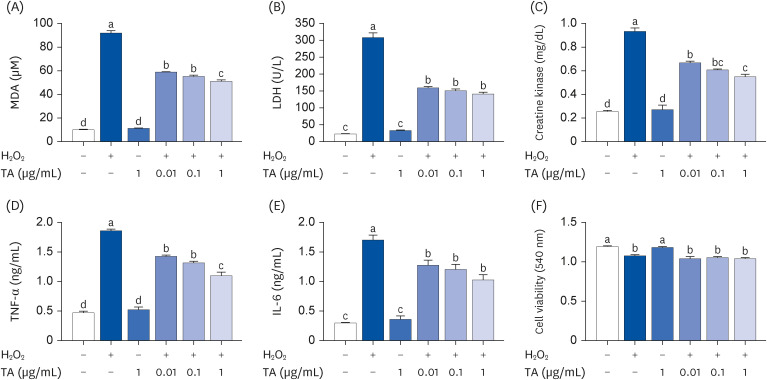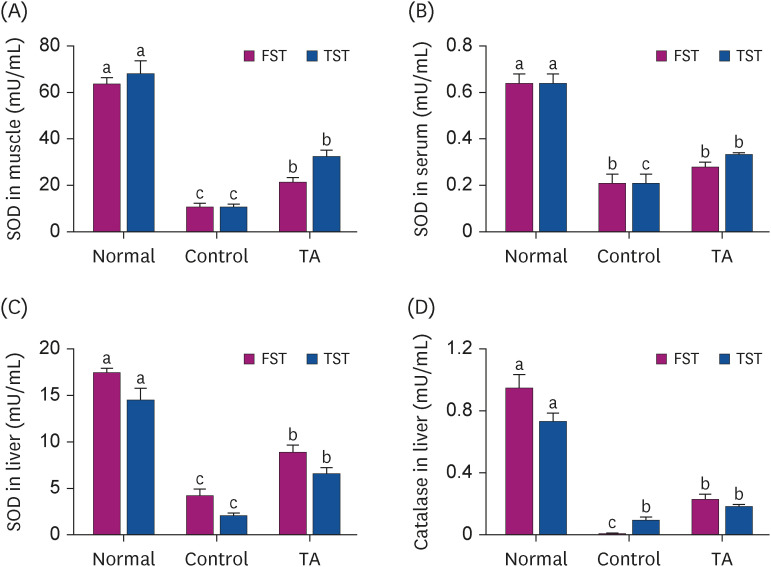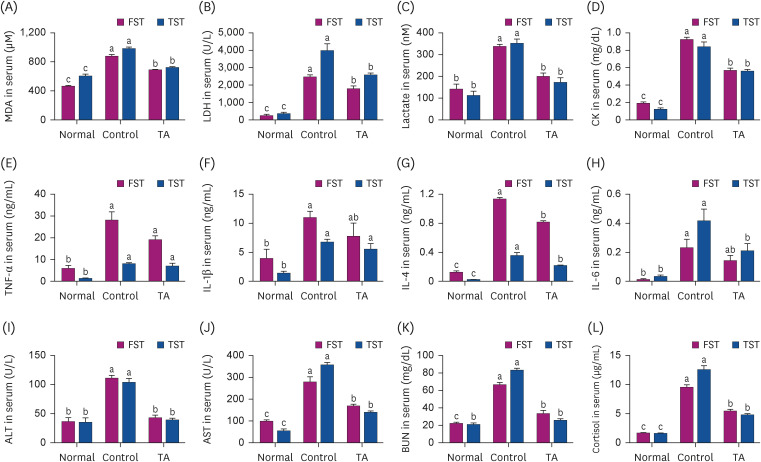Nutr Res Pract.
2023 Aug;17(4):670-681. 10.4162/nrp.2023.17.4.670.
Anti-fatigue effect of tormentic acid through alleviating oxidative stress and energy metabolism-modulating property in C2C12 cells and animal models
- Affiliations
-
- 1Department of Bio-Convergence System, Graduate School, Hoseo University, Asan 31499, Korea
- 2BioChip Research Center, Hoseo University, Asan 31499, Korea
- 3Department of Science in Korean Medicine, Graduate School, Kyung Hee University, Seoul 02447, Korea
- KMID: 2545184
- DOI: http://doi.org/10.4162/nrp.2023.17.4.670
Abstract
- BACKGROUND/OBJECTIVES
Oxidative stress is caused by reactive oxygen species and free radicals that accelerate inflammatory responses and exacerbate fatigue. Tormentic acid (TA) has antioxidant and anti-inflammatory properties. Thus, the aim of present study is to determine the fatigue-regulatory effects of TA in H2O2 -stimulated myoblast cell line, C2C12 cells and treadmill stress test (TST) and forced swimming test (FST) animal models.
MATERIALS/METHODS
In the in vitro study, C2C12 cells were pretreated with TA before stimulation with H2O2 . Then, malondialdehyde (MDA), lactate dehydrogenase (LDH), creatine kinase (CK) activity, tumor necrosis factor (TNF)-α, interleukin (IL)-6, superoxide dismutase (SOD), catalase (CAT), glycogen, and cell viability were analyzed. In the in vivo study, the ICR male mice were administered TA or distilled water orally daily for 28 days. FST and TST were then performed on the last day. In addition, biochemical analysis of the serum, muscle, and liver was performed.
RESULTS
TA dose-dependently alleviated the levels of MDA, LDH, CK activity, TNF-α, and IL-6 in H2O2 -stimulated C2C12 cells without affecting the cytotoxicity. TA increased the SOD and CAT activities and the glycogen levels in H2O2 -stimulated C2C12 cells. In TST and FST animal models, TA decreased the FST immobility time significantly while increasing the TST exhaustion time without weight fluctuations. The in vivo studies showed that the levels of SOD, CAT, citrate synthase, glycogen, and free fatty acid were increased by TA administration, whereas TA significantly reduced the levels of glucose, MDA, LDH, lactate, CK, inflammatory cytokines, alanine transaminase, aspartate transaminase, blood urea nitrogen, and cortisol compared to the control group.
CONCLUSIONS
TA improves fatigue by modulating oxidative stress and energy metabolism in C2C12 cells and animal models. Therefore, we suggest that TA can be a powerful substance in healthy functional foods and therapeutics to improve fatigue.
Figure
Reference
-
1. Ament W, Verkerke GJ. Exercise and fatigue. Sports Med. 2009; 39:389–422. PMID: 19402743.
Article2. Sechi S, Fiore F, Chiavolelli F, Dimauro C, Nudda A, Cocco R. Oxidative stress and food supplementation with antioxidants in therapy dogs. Can J Vet Res. 2017; 81:206–216. PMID: 28725111.3. Chen WC, Hsu YJ, Lee MC, Li HS, Ho CS, Huang CC, Chen FA. Effect of burdock extract on physical performance and physiological fatigue in mice. J Vet Med Sci. 2017; 79:1698–1706. PMID: 28890521.
Article4. Hsu YJ, Huang WC, Lin JS, Chen YM, Ho ST, Huang CC, Tung YT. Kefir supplementation modifies gut microbiota composition, reduces physical fatigue, and improves exercise performance in mice. Nutrients. 2018; 10:862. PMID: 29973525.
Article5. Shang H, Cao S, Wang J, Zheng H, Putheti R. Glabridin from Chinese herb licorice inhibits fatigue in mice. Afr J Tradit Complement Altern Med. 2009; 7:17–23. PMID: 21304608.
Article6. Wang L, Zhang HL, Lu R, Zhou YJ, Ma R, Lv JQ, Li XL, Chen LJ, Yao Z. The decapeptide CMS001 enhances swimming endurance in mice. Peptides. 2008; 29:1176–1182. PMID: 18440669.
Article7. He Q, Sawada M, Yamasaki N, Akazawa S, Furuta H, Uenishi H, Meng X, Nakahashi T, Ishigaki Y, Moriya J. Neuroinflammation, oxidative stress, and neurogenesis in a mouse model of chronic fatigue syndrome, and the treatment with Kampo medicine. Biol Pharm Bull. 2020; 43:110–115. PMID: 31902915.
Article8. Kawamura T, Muraoka I. Exercise-induced oxidative stress and the effects of antioxidant intake from a physiological viewpoint. Antioxidants (Basel). 2018; 7:119. PMID: 30189660.
Article9. Huang WC, Chiu WC, Chuang HL, Tang DW, Lee ZM, Wei L, Chen FA, Huang CC. Effect of curcumin supplementation on physiological fatigue and physical performance in mice. Nutrients. 2015; 7:905–921. PMID: 25647661.
Article10. Kim HY, Han NR, Kim NR, Lee M, Kim J, Kim CJ, Jeong HJ, Kim HM. Effect of fermented porcine placenta on physical fatigue in mice. Exp Biol Med (Maywood). 2016; 241:1985–1996. PMID: 27439540.
Article11. Mantovani G, Macciò A, Madeddu C, Mura L, Gramignano G, Lusso MR, Mulas C, Mudu MC, Murgia V, Camboni P, et al. Quantitative evaluation of oxidative stress, chronic inflammatory indices and leptin in cancer patients: correlation with stage and performance status. Int J Cancer. 2002; 98:84–91. PMID: 11857390.
Article12. Alessio HM, Hagerman AE, Fulkerson BK, Ambrose J, Rice RE, Wiley RL. Generation of reactive oxygen species after exhaustive aerobic and isometric exercise. Med Sci Sports Exerc. 2000; 32:1576–1581. PMID: 10994907.
Article13. Hussain SP, Harris CC. Inflammation and cancer: an ancient link with novel potentials. Int J Cancer. 2007; 121:2373–2380. PMID: 17893866.
Article14. Wang YL, Sun GY, Zhang Y, He JJ, Zheng S, Lin JN. Tormentic acid inhibits H2O2-induced oxidative stress and inflammation in rat vascular smooth muscle cells via inhibition of the NF-κB signaling pathway. Mol Med Rep. 2016; 14:3559–3564. PMID: 27572426.
Article15. Jiang WP, Huang SS, Matsuda Y, Saito H, Uramaru N, Ho HY, Wu JB, Huang GJ. Protective effects of tormentic acid, a major component of suspension cultures of Eriobotrya japonica cells, on acetaminophen-induced hepatotoxicity in mice. Molecules. 2017; 22:830. PMID: 28524081.
Article16. Banno N, Akihisa T, Tokuda H, Yasukawa K, Higashihara H, Ukiya M, Watanabe K, Kimura Y, Hasegawa J, Nishino H. Triterpene acids from the leaves of Perilla frutescens and their anti-inflammatory and antitumor-promoting effects. Biosci Biotechnol Biochem. 2004; 68:85–90. PMID: 14745168.
Article17. Park GH, Lee JY, Kim DH, Cho YJ, An BJ. Anti-oxidant and anti-inflammatory effects of Rosa multiform root. J Life Sci. 2011; 21:1120–1126.18. Smith PK, Krohn RI, Hermanson GT, Mallia AK, Gartner FH, Provenzano MD, Fujimoto EK, Goeke NM, Olson BJ, Klenk DC. Measurement of protein using bicinchoninic acid. Anal Biochem. 1985; 150:76–85. PMID: 3843705.
Article19. Nam SY, Kim HY, Min JY, Kim HM, Jeong HJ. An osteoclastogenesis system, the RANKL/RANK signalling pathway, contributes to aggravated allergic inflammation. Br J Pharmacol. 2019; 176:1664–1679. PMID: 30737962.
Article20. Kim HY, Kang HG, Nam SY, Kim HM, Jeong HJ. Blockade of RANKL/RANK signaling pathway by epigallocatechin gallate alleviates mast cell-mediated inflammatory reactions. Int Immunopharmacol. 2020; 88:106872. PMID: 32769069.
Article21. Culotta VC, Yang M, O’Halloran TV. Activation of superoxide dismutases: putting the metal to the pedal. Biochim Biophys Acta. 2006; 1763:747–758. PMID: 16828895.
Article22. Ho YS, Xiong Y, Ma W, Spector A, Ho DS. Mice lacking catalase develop normally but show differential sensitivity to oxidant tissue injury. J Biol Chem. 2004; 279:32804–32812. PMID: 15178682.
Article23. Han NR, Kim HY, Kim NR, Lee WK, Jeong H, Kim HM, Jeong HJ. Leucine and glycine dipeptides of porcine placenta ameliorate physical fatigue through enhancing dopaminergic systems. Mol Med Rep. 2018; 17:4120–4130. PMID: 29286166.
Article24. Abdelhalim MA, Moussa SA, Qaid HA. The protective role of quercetin and arginine on gold nanoparticles induced hepatotoxicity in rats. Int J Nanomedicine. 2018; 13:2821–2825. PMID: 29785108.
Article25. Liang X, Liu L, Fu T, Zhou Q, Zhou D, Xiao L, Liu J, Kong Y, Xie H, Yi F, et al. Exercise inducible lactate dehydrogenase B regulates mitochondrial function in skeletal muscle. J Biol Chem. 2016; 291:25306–25318. PMID: 27738103.
Article26. Kim TW, Park SS, Kim BK, Sim YJ, Shin MS. Effects of sildenafil citrate on peripheral fatigue and exercise performance after exhaustive swimming exercise in rats. J Exerc Rehabil. 2019; 15:751–756. PMID: 31938694.
Article27. Filho LF, Menezes PP, Santana DV, Lima BS, Saravanan S, Almeida GK, Filho JE, Santos MM, Araújo AA, de Oliveira ED. Effect of pulsed therapeutic ultrasound and diosmin on skeletal muscle oxidative parameters. Ultrasound Med Biol. 2018; 44:359–367. PMID: 29126754.
Article28. Baird MF, Graham SM, Baker JS, Bickerstaff GF. Creatine-kinase- and exercise-related muscle damage implications for muscle performance and recovery. J Nutr Metab. 2012; 2012:960363. PMID: 22288008.
Article29. Houmard JA, Costill DL, Mitchell JB, Park SH, Fink WJ, Burns JM. Testosterone, cortisol, and creatine kinase levels in male distance runners during reduced training. Int J Sports Med. 1990; 11:41–45. PMID: 2180832.
Article30. Lee JS, Kim HG, Han JM, Kim YA, Son CG. Anti-fatigue effect of Myelophil in a chronic forced exercise mouse model. Eur J Pharmacol. 2015; 764:100–108. PMID: 26142828.
Article31. Ksontini R, MacKay SL, Moldawer LL. Revisiting the role of tumor necrosis factor alpha and the response to surgical injury and inflammation. Arch Surg. 1998; 133:558–567. PMID: 9605921.
Article32. Powers SK, Deminice R, Ozdemir M, Yoshihara T, Bomkamp MP, Hyatt H. Exercise-induced oxidative stress: friend or foe? J Sport Health Sci. 2020; 9:415–425. PMID: 32380253.
Article33. Emhoff CA, Messonnier LA, Horning MA, Fattor JA, Carlson TJ, Brooks GA. Gluconeogenesis and hepatic glycogenolysis during exercise at the lactate threshold. J Appl Physiol. 2013; 114:297–306. PMID: 23239870.
Article34. Hargreaves M. Exercise, muscle, and CHO metabolism. Scand J Med Sci Sports. 2015; 25(Suppl 4):29–33. PMID: 26589114.35. Chen WC, Huang WC, Chiu CC, Chang YK, Huang CC. Whey protein improves exercise performance and biochemical profiles in trained mice. Med Sci Sports Exerc. 2014; 46:1517–1524. PMID: 24504433.
Article36. Mika A, Macaluso F, Barone R, Di Felice V, Sledzinski T. Effect of exercise on fatty acid metabolism and adipokine secretion in adipose tissue. Front Physiol. 2019; 10:26. PMID: 30745881.
Article37. Ren Y, Li Y, Lv J, Guo X, Zhang J, Zhou D, Zhang Z, Xue Z, Yang G, Xi Q, et al. Parthenolide regulates oxidative stress-induced mitophagy and suppresses apoptosis through p53 signaling pathway in C2C12 myoblasts. J Cell Biochem. 2019; 120:15695–15708. PMID: 31144365.
Article38. Zhu H, Xu W, Wang N, Jiang W, Cheng Y, Guo Y, Yao W, Hu B, Du P, Qian H. Anti-fatigue effect of Lepidium meyenii Walp. (Maca) on preventing mitochondria-mediated muscle damage and oxidative stress in vivo and vitro . Food Funct. 2021; 12:3132–3141. PMID: 33729250.
Article39. Ratkevicius A, Carroll AM, Kilikevicius A, Venckunas T, McDermott KT, Gray SR, Wackerhage H, Lionikas A. H55N polymorphism as a likely cause of variation in citrate synthase activity of mouse skeletal muscle. Physiol Genomics. 2010; 42A:96–102. PMID: 20716647.
Article40. Shiffman ML, Pockros P, McHutchison JG, Schiff ER, Morris M, Burgess G. Clinical trial: the efficacy and safety of oral PF-03491390, a pancaspase inhibitor - a randomized placebo-controlled study in patients with chronic hepatitis C. Aliment Pharmacol Ther. 2010; 31:969–978. PMID: 20163376.41. Bekker A, Haile M, Kline R, Didehvar S, Babu R, Martiniuk F, Urban M. The effect of intraoperative infusion of dexmedetomidine on the quality of recovery after major spinal surgery. J Neurosurg Anesthesiol. 2013; 25:16–24. PMID: 22824921.
Article42. Hsu YJ, Huang WC, Chiu CC, Liu YL, Chiu WC, Chiu CH, Chiu YS, Huang CC. Capsaicin supplementation reduces physical fatigue and improves exercise performance in mice. Nutrients. 2016; 8:648. PMID: 27775591.
Article43. Qu Y, Ji H, Song W, Peng S, Zhan S, Wei L, Chen M, Zhang D, Liu S. The anti-fatigue effect of the Auxis thazard oligopeptide via modulation of the AMPK/PGC-1α pathway in mice. Food Funct. 2022; 13:1641–1650. PMID: 35080545.
Article
- Full Text Links
- Actions
-
Cited
- CITED
-
- Close
- Share
- Similar articles
-
- Effect of Hydrogen Peroxide-induced Oxidative Stress on the Senescence of Trabecular Meshwork Cells
- Protectins Effects of Vitamin E against Immobilization Stress-Induced Oxidative Damage in Rat Brain
- Cancer Energy Metabolism: Shutting Power off Cancer Factory
- High glucose stimulates glutamate uptakes in pancreatic beta-cells
- Effect of Ascorbic Acid Against the Oxidative Stress-Induced Cellular Senescence in Trabecular Meshwork Cells







